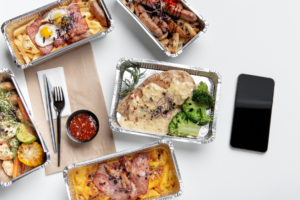This blog explores the impact, challenges, and future trends of food and grocery delivery apps.
Introduction
In today’s fast-paced world, convenience is king, and nowhere is this more evident than in the food and grocery industry. With the advent of smartphones and the ever-growing app ecosystem, food and grocery delivery apps have become an integral part of our daily lives. These apps have not only changed the way we dine but have also transformed the way we shop for groceries. As an app development agency, we are excited to delve into the realm of food and grocery delivery apps and explore how they are reshaping the culinary landscape.
The Rise of Food and Grocery Delivery Apps
The rise of food and grocery delivery apps can be attributed to several factors, including the increasing reliance on smartphones, the demand for convenience, and the changing consumer habits. Let’s take a closer look at these trends:
- Smartphone Proliferation: The widespread adoption of smartphones has made it easier for consumers to access a variety of services, including food and grocery delivery. With a few taps on their screens, users can browse menus, place orders, and have food or groceries delivered to their doorstep.
- Convenience Culture: In today’s busy world, people value convenience above all else. Food and grocery delivery apps offer a hassle-free way to access meals and essentials without the need to cook or visit a physical store. This convenience factor has been a driving force behind the popularity of these apps.
- Changing Dining Habits: The COVID-19 pandemic accelerated the shift toward online ordering and food delivery. Many consumers who were once hesitant to order food online now consider it a safer and more convenient option. This shift in dining habits has led to a surge in food delivery app usage.

Key Features of Food and Grocery Delivery Apps
Successful food and grocery delivery apps share common features that cater to both customers and businesses:
- User-Friendly Interface: Intuitive and user-friendly interfaces make it easy for customers to browse menus, select items, and place orders quickly.
- Payment Options: Multiple payment options, including credit cards, digital wallets, and cash on delivery, cater to a wide range of customers.
- Real-Time Tracking: Order tracking features allow customers to monitor the status and location of their deliveries in real-time, enhancing transparency and trust.
- Restaurant/Grocery Store Listings: Comprehensive listings of restaurants or grocery stores, complete with menus, prices, and user reviews, help customers make informed choices.
- Delivery Drivers: Apps connect customers with delivery drivers or couriers, facilitating efficient and timely deliveries.
- Promotions and Discounts: Offering special promotions, discounts, and loyalty programs keeps customers engaged and encourages repeat orders.

Benefits for Businesses
Food and grocery delivery apps not only cater to consumer needs but also provide significant benefits to businesses:
- Expanded Customer Base: Restaurants and grocery stores can reach a wider audience by partnering with delivery apps, increasing their sales potential.
- Streamlined Operations: Apps can help businesses streamline their order management, reducing the risk of errors and improving efficiency.
- Customer Insights: Access to customer data and ordering patterns allows businesses to tailor their offerings and marketing strategies.
- Brand Visibility: Being featured on popular delivery apps enhances a business’s visibility and credibility in the market.

Challenges and Future Trends
While food and grocery delivery apps have revolutionized the industry, they also face challenges such as competition, delivery logistics, and maintaining food quality. Additionally, as technology continues to advance, we can expect several trends to shape the future of these apps:
- Sustainability: The demand for sustainable and eco-friendly packaging and delivery options is on the rise.
- Integration of AI and Data Analytics: AI-powered recommendations and data-driven insights will enhance the user experience and help businesses make informed decisions.
- Ghost Kitchens: The rise of virtual or ghost kitchens, which operate solely for delivery, will further transform the restaurant landscape.

Conclusion
Food and grocery delivery apps have become an integral part of modern living, offering convenience and a wide range of options to consumers while presenting new opportunities for businesses. As an app development agency, we are excited to be a part of this culinary revolution, continually innovating and helping businesses and entrepreneurs create exceptional delivery apps that cater to the evolving needs of today’s customers. The future of food and grocery delivery apps is indeed bright, promising even more convenience, choice, and satisfaction for everyone involved.


